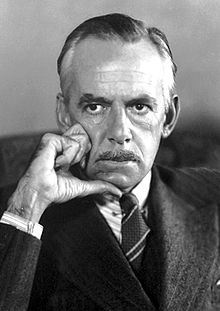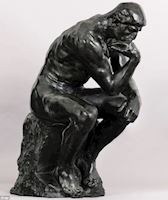Eugene O'Neill

I love life, but I don't love life because it is pretty. Prettiness is only clothes-deep. I am a truer lover than that. I love it naked. There is beauty to me even in its ugliness. In fact, I deny the ugliness entirely, for its vices are often nobler that its virtues and nearly always closer to a revelation.
I am always acutely conscious of the forces behind---Fate, God, our biological past---creating our present.
- Eugene O'Neill
- Yank, the Yankee who yanks and is being yanked throughout The Hairy Ape, is obviously construed as a type of modern industrialized man, as a member of the labor classes, and as much more...... Try to identify the most important roles and stages in Yank's development and, within your group, come to some sort of resolution about the play's ambiguous ending. What precisely happens to Yank at the end, as he in effect trades places with another ape?
- Scene iii in the stokehold can easily be seen as a central encounter (before Yank meets an embodiment of himself, of sorts, in the end). What can you make of Mildred and Yank's reactions about one another? What do they stand for, and what do they recognize within themselves as they see the other? Why, do you think, does the scene take place in the stokehold?
- Critics frequently note that O'Neill is working out his personal problems -- and particularly his problematic relation with women -- in his plays. What evidence can you find in The Hairy Ape to make this claim? How are women in general presented in the play?
- Plays with expressionistic elements frequently draw on sharp contrasts to the foreground and stylize (that is, distort) difference. What are some of the major contrasts you recognize in The Hairy Ape? Many of these contrasts are dramatized, both literally and figuratively, in scene iii, the crucial encounter between the two representatives of the class, gender, etc., but important contrasts are visible in other scenes as well. What major binaries and oppositions can you identify, and what might be their function in a play--and The Hairy Ape in particular?
- In 1941, nineteen years after he had written The Hairy Ape, Eugene O'Neill wrote that "The Hairy Ape is ripe for revival. It is, spiritually speaking, a surprisingly prophetic play... The symbol and real meaning would be much clearer now than when it was done. Very few got it then [in 1922]" (Selected Letters 522). What may O'Neill have had in mind when he made those observations? In what sense could the play be considered prophetic, from a spiritual point of view? Why did few people understand it, it seems, at that time? In answering these questions, you may also want to think about current national and/or world political events? Do you see any forms of parallelism or divergences — political, historical, artistic -- between the early 20s and the early 40s?
Questions for the entire class to consider
- A critic once commented that The Hairy Ape has a "weak spot," in that the play comes to a climax early in scene iii -- the fateful encounter between Yank and Mildred in the stokehold -- without reaching similar moments later in its development. Supported largely by Yank's monologues, the play, instead of reaching another high point toward the end, appears to simply peter out: "After broad brush strokes in the early scenes, the line of development carried mainly by Yank's monologues, however, distinguished in its own rough way, seems rather thin. Trying to see the play as a figure we might speak of the letter Y lying prone; the strongest point is that at which the two expository lines meet. The emphasis on the play is, in other words, too strongly on the focal scenic image of Scene iii; it is possible to imagine audiences sitting spellbound up to Scene iv and then starting to look forward to an appropriately powerful climax--which never comes...." (Tiusanen, O'Neill's Scenic Images, Princeton UP: 1968, p. 125). What is your reaction to this observation? Do you feel that the play loses steam after the initial encounter between Yank and Mildred? Do you see other high dramatic moments later in the play? Assuming that scene iii is, indeed, the climax of the play, why would O'Neill structure The Hairy Ape in such a way (that is, manage its dynamic energy to yield a rather flat denouement)?
- Early critics of O'Neill predicted that he would eventually switch from play- to novel-writing, and O'Neill himself frequently reiterated not only his interest in 19th and early 20th-century narratives but also his goal to exploit the capacities of the modern novel for modern drama. In particular, he was enamored of the novelist's total artistic control of his work, in contrast to the playwright's dependence on the vicissitudes of the stage production (actors, directors, the stage itself, etc.). Apparently, in some instances, he would have preferred for his plays to remain unperformed on stage, performed only in the minds of readers. As he put it in 1929: "I think I will wind up writing plays to be published with 'No Productions Allowed' in red letters on the first page--for when I think of that dreary ordeal of disillusionment and compromise called rehearsals, with the best end in sight a 'competent' production, I sure turn sick! The ideas for the plays I am writing and going to write are too dear to me, too much travail of blood and spirit will go down into their writing, for me to expose them to what I know is an unfair test. I would rather place them directly from my imagination to the imagination of the reader" (Selected Letters 339). O'Neill made this pronouncement roughly seven years after The Hairy Ape (1922) was first produced. Yet: what connections can you see between this early play and his reservations toward stage productions? Do you see moments or elements in the play that are "novelistic" in character? At what moments could The Hairy Ape be seen to be "constantly overreaching the medium," as O'Neill once put it (Selected Letters 488)? --Speculate and theorize!
 The bronze sculpture The Thinker, by French artist Auguste Rodin, was originally intended to crown the Gates of Hell, a monumental entrance to the Musée des Arts Décoratifs in Paris. Inspired by the Inferno of Italian poet Dante Alighieri and the volume Flowers of Evil by French poet Charles Baudelaire, the sculptural program for the Gates of Hell reflected a deeply pessimistic view of human life and happiness. The Gates were never completed, and the pieces created for them—including Rodin's The Thinker and The Kiss—are now exhibited separately as independent works.
The bronze sculpture The Thinker, by French artist Auguste Rodin, was originally intended to crown the Gates of Hell, a monumental entrance to the Musée des Arts Décoratifs in Paris. Inspired by the Inferno of Italian poet Dante Alighieri and the volume Flowers of Evil by French poet Charles Baudelaire, the sculptural program for the Gates of Hell reflected a deeply pessimistic view of human life and happiness. The Gates were never completed, and the pieces created for them—including Rodin's The Thinker and The Kiss—are now exhibited separately as independent works.
“He could not set down a creative thought except in his own hand. It was impossible for him to dictate or use a typewriter” - Gelbs 6
“He has done much of his more recent writing in an enormous chair that he had manufactured for himself in England. It is a cross between a dentist’s and a barber’s chair, with all sorts of pull-in and pull-out contrivances attached to it and with a couple of small shelves for reference books. A board is so arranged that it can be maneuvered in front of him and on it, he rests his pad. Stripped to the waist—he never works, if he can help it, with anything on above his navel—and with his legs stretched out to their full length, he writes everything in longhand and his chirography is so minute that it takes a magnifying glass for average eyes comfortably to read it” - from a 1932 article on O'Neill
"Ah, whither shall I ascend with my longing! From all mountains do I look out for fatherlands and motherlands. But a home have I found nowhere; unsettled as I in all cities, and decamping at all gates." - phrase underlined by O'Neill in his treasured and worn copy of Friedrich Nietzsche's Thus Spake Zarathustra
